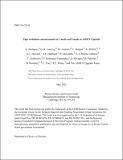Edge turbulence measurements in L-mode and I-mode at ASDEX Upgrade
Author(s)
Bielajew, R.; Conway, G.D.; Griener, M.; Happel, T.; Höfler, K.; Howard, Nathan T.; Hubbard, Amanda E.; McCarthy, William; Molina Cabrera, Pedro A.; Nishizawa, T.; Rodriguez-Fernandez, P.; Silvagni, D.; Vanovac, B.; Wendler, D.; Yoo, C.; White, Anne E.; The ASDEX Upgrade Team; ... Show more Show less
Download22ja010_full.pdf (2.633Mb)
Metadata
Show full item recordAbstract
The I-mode confinement regime is promising for future reactor operation due to high energy confinement without high particle confinement. However, the role of edge turbulence in creating I-mode's beneficial transport properties is still unknown. New measurements of edge turbulence in L-modes and I-modes at low and high densities at ASDEX Upgrade are presented in this paper. A high radial resolution correlation electron cyclotron emission radiometer measures the broadband turbulence throughout the L-mode and I-mode edge and pedestal. The weakly coherent mode (WCM) is measured in both L-mode and I-mode near the last closed flux surface with Te fluctuation levels of 2.3%–4.2%, with a frequency shift between the two phases related to a deeper Er well in I-mode. An nT phase diagnostic captures a change of the WCM nT phase between L-mode and I-mode. The thermal He beam diagnostic measures a WCM wavenumber range of −0.5 to −1.0 cm−1. A low-frequency edge oscillation (LFEO) appears in the I-mode phase of these discharges and displays coupling to the WCM, but the LFEO does not appear in the L-mode phase. Linear gyrokinetic simulations of the outer core and pedestal top turbulence indicate that while the dominant turbulent modes in the outer core are ion directed and electrostatic, the turbulence becomes increasingly electron directed and electromagnetic with increasing radius. Collisionality is not found to impact characteristics of the L-mode and I-mode edge turbulence with respect to the presence of the WCM; however, the quality of global confinement decreases with collisionality.
Description
Submitted for publication in Physics of Plasmas
Date issued
2022-05Department
Massachusetts Institute of Technology. Plasma Science and Fusion CenterJournal
Physics of Plasmas
Publisher
AIP
Other identifiers
22ja010